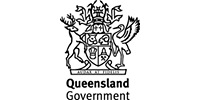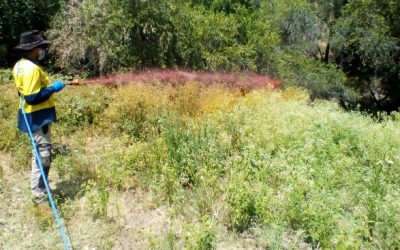Invasive Weed Control in the Barambah and Boonara Catchments
2018 - 2019Round 2 of the Community Sustainability Action grants – Environment Conservation funding, focuses on connecting communities to the environment for eligible organisations to undertake on-ground activities to rehabilitate degraded landscapes, protect and improve habitat and biodiversity and improve the climate resilience of natural environments. In 2018, BCCA successfully obtained a grant to collaborate with Gympie Regional Council (GRC) to monitor current infestation levels of Rubber Vine (RL), Parthenium and Honey Locust (HL) in the Barambah, Boonara Creek and sections of the Moonda Waamba Creek located in the GRC area.
Project Aims & Outcomes

The project aims to monitor current infestation levels of Rubber Vine, Parthenium Weed and Honey Locust in the Barambah, Boonara Creek and sections of the Moonda Waamba Creek located in the Gympie Regional Council (GRC) area. GRC will engage a drone to survey deep gorges and difficult terrain areas to limit the amount of time involved in surveying. A weeds contractor will then treat approximately 50m either side of these identified areas of invasive weed infestation, covering an area of approximately 800ha and 70km of riparian area. This project will include monitoring of the treatment areas and landholder and community education as part of the long term activities of the eradication program.
This project will build on previous project works which involved treatment of targeted declared plants (Rubber Vine & Parthenium) in the Barambah, Boonara and sections of the Moonda Waamba creek. Current visual surveys in the GRC area, indicate that the distribution of these species is currently low due to previous control measures. Weed control work under this proposal would lead to a high chance of areas becoming weed free or at a manageable level for the participating landholders.
Extension and awareness will focus on, increasing the awareness of these weeds (identification, vectors of spread and control) to provide the community with ability to maintain the catchment free of these weeds, and promoting the need for early intervention which will build desire of the community within the project area to respond to new infestations in the future.
Initial chemical treatment of the project area for Parthenium, Rubber Vine and Honey Locust was 862 hectares. The project area was found to have a higher Parthenium infestation level than initially anticipated and the contractors felt best to do a more thorough initial treatment rather than spraying less of the infestation at the outset and following up later due to the vigorous nature of the species.
Drone survey of the project area in May 2019 was conducted over 886 hectares. Rubber Vine regrowth was evident in a 100 hectare stretch of the Lower Boonara Creek. Treatment of Rubber Vine corresponded to the weed flowering, thus reducing seed pod formation which would subsequently be scattered by the wind and also carried downstream by water. Parthenium follow up treatment was limited due to a lack of funds. Contractors managed to retreat a 54 hectare area on the Lower Boonara Creek which had a very high infestation of Parthenium. Continued local Council and Landholder involvement outside the grant will be required to maintain a control on the Parthenium. The isolated infestation of Honey Locust along 3km of Ettrickdale Road along the Boonara Creek, was chemically treated in December 2018, follow up ground survey in May 2019 revealed no evidence of Honey Locust in the treatment area. Treating the Honey Locust when in flower prevents it from developing the characteristic long brown pods which are spread by grazing stock eating the pods and passing seed in dung and also spread of pods downstream via floodwaters. Overall, 70 kilometers of riverbank was remediated during the project through chemical control of Rubber Vine, Honey Locust and Parthenium.
The opportunity to build on previous project works on properties, which involved treatment of targeted declared weeds (Rubber Vine and Parthenium), in the project area was very positive about the Community Sustainability Action Grant (CSAG). Treatment works undertaken as part of the previous project resulted in control of approximately 800ha of Rubber vine and Parthenium in the Barambah and Boonara Catchments. Funding through CSAG will lead to a high chance of areas becoming weed free or at a manageable level for the participating landholders. Extension and awareness provided to landholders in the treatment area by Gympie Regional Council land protection officers, landholders will have the ability to identify these invasive weeds with early intervention to new infestations will in the long-term give the community the ability to maintain the work achieved under the CSAG.


Program News

Barambah & Boonara Catchment Weed Project
BCCA’s Community Sustainability Action Grant (CSAG) —Invasive Weed Control in the Barambah and Boonara Catchments project had come to completion. The project commenced in 2018 and aimed to monitor and treat infestation levels of Rubber Vine, Parthenium Weed and Honey...
Barambah and Boonara Weeds Project
BCCA in collaboration with Gympie Regional Council (GRC) are well into our 'Community Sustainability Action Grant' project, which aims to monitor current infestation levels of Rubber Vine (RV), Parthenium Weed and Honey Locust (HL) in the Barambah, Boonara Creek and...
Barambah and Boonara Weed Control Project
In 2018, BCCA successfully obtained a ‘Community Sustainability Action Grant’ to collaborate with Gympie Regional Council (GRC), to monitor current infestation levels of Rubber Vine (RV), Parthenium Weed and Honey Locust (HL) in the Barambah, Boonara Creek and...
Program Sponsors
This project was supported by the following partners and investors.





